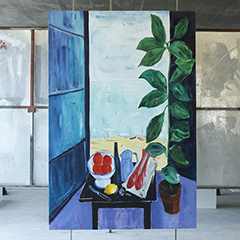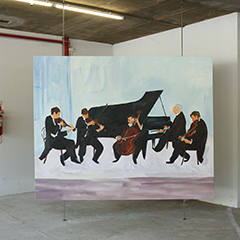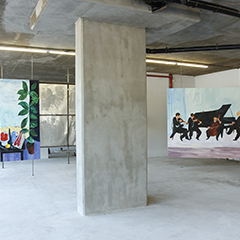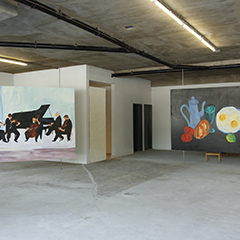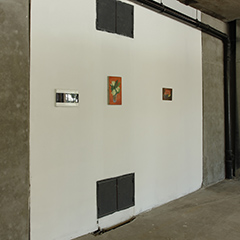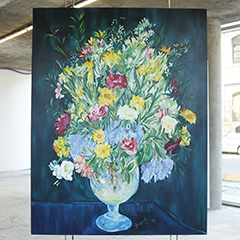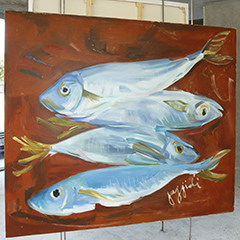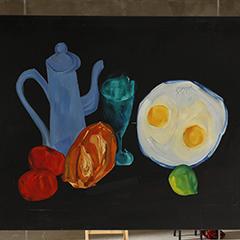Pan Dulce, Pasto (Brasil) Gallery
Ciudad de Buenos Aires, Argentina. Curator & text: Florencia Qualina, 2019
Pancalism, by Florencia Qualina
In Pan Dulce [Panettone], Cynthia Cohen recreates a set of works by Juan Carlos Faggioli, her grandfather; these are small format paintings portraying orchestras, indoor environments, and dead nature made by the end of the sixties and the mid-seventies when he had already been famous for a long time for being a master of easel painting and when he would get involved in debates with internationalist avant-garde art agents.
Cynthia meticulously resumes the images that were part of her childhood landscape. She paints them with the same proportion of faithfulness and caprice. She follows the color palette, the pace of brush-strokes; she replicates Faggioli’s signature—symbol of originality and mastery—but introduces a drastic change: paintings are huge. Their huge size provides them with a new twist, surrealist at times: fish, fried eggs, and watermelons are given puzzling, oneiric humor. Joyful lyricism emerges from other scenes. Radiant vases seem to say, in F. Schlegel’s words: “For once we know to a certainty that we live in a most beautiful world”.
If Faggioli’s paintings are contained and fall within an academic tradition they defend tenaciously (his battles with Romero Brest illustrate a reactive positioning in view of the youth advance), Cynthia’s work on them is a conceptual operation on the still life/dead nature genre. The diversion of the copy gives rise to singularity, a kind of defining key. As a result of the size gained, they become excessive, carnal; they also invert the mandate that, from time immemorial, provided that women should carry out small works. The big format is always, for a female artist, a territorial conquest.
Faggioli, the anarchist, traveler, polemicist, music lover, got many distinctions during his long career in art. A very remarkable one was receiving the Prize of the XL Salón Nacional de Bellas Artes [XL National Hall of Fine Arts] from Eva Perón for his work Pan Dulce. Another one, as memorable as well as conflicting, was having a foreword written by Jorge Luis Borges, entitled De la pintura [About the Painting], for one of his exhibitions. There, he wrote: “All beings struggle against time, which finally destroys and forgets them; most of them ignore it because they lack time awareness.
Seneca observed that animals live a pure present, with no before or after; Yeats, based on Berkeley’s philosophy, coined his magnificent line: Man has created death. Like other arts, painting is a medium, maybe the most efficient and tangible one, to rescue something of what is taken away by centuries”. Upon going over the familiar language, Cohen somehow continues that path. Going back to the past to reinvent it.
Florencia Qualina, 2019
